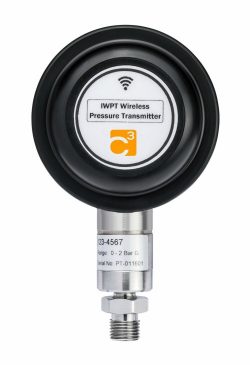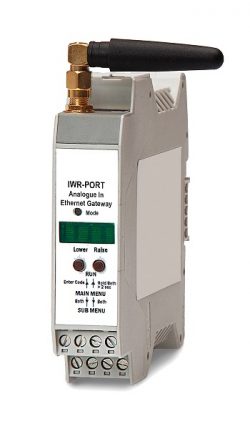
A specialist in Unmanned Surface Vehicles (USVs) required a robust solution for monitoring pressure at multiple points within their onboard seawater fire suppression system. The application presented several challenges inherent to unmanned marine operations, including the need for a wireless setup to avoid complex cabling, long-term reliability with minimal maintenance, seamless data integration with an existing RS485 PLC network, and avoidance of RF interference with other critical systems. Furthermore, the use of seawater as the media required careful consideration of material compatibility, which was addressed by the client’s specific operational and maintenance protocols involving short-term testing and subsequent fresh-water rinsing of the sensors.
- Application: Remotely monitoring pressure up to 50 bar in the seawater fire suppression piping on an unmanned boat.
- Proposed Solution: A system of IWPT wireless pressure transducers transmitting data to a single IWR-PORT wireless gateway with an RS485 output.
- Material Compatibility: The sensor’s wetted parts—316 Stainless Steel, Viton, and Ceramic —were deemed suitable for the application’s short-term testing cycles when combined with the client’s post-use washout procedure.
- Interference Mitigation: The sensors operate on a 2.4 GHz frequency and feature a user-selectable DIL switch to change channels, preventing interference with other onboard Wi-Fi and communication systems.
- Power & Maintenance: The wireless transducers are powered by a Lithium C cell battery, offering a five-year lifespan at a 10-second transmission update rate, minimizing maintenance needs for the unmanned vessel.
- Data Integration: The IWR-PORT gateway seamlessly converts the wireless sensor data to an RS485 signal using the MODBUS RTU protocol for direct integration into the existing onboard PLC or computer.
A company specializing in the development and operation of Unmanned Surface Vehicles (USVs) had a critical requirement for monitoring onboard fire suppression systems. The unique operational nature of USVs, which function without onboard personnel, necessitates highly reliable and autonomous monitoring of all critical systems, including the pressure within the fire suppression piping. They needed to integrate multiple pressure sensors at various points within the seawater-based fire system. Key challenges included ensuring real-time data transmission to an existing Programmable Logic Controller (PLC) or computer via RS485, mitigating potential wireless interference from other onboard systems, achieving a practical battery lifespan to minimize maintenance on the unmanned vessel, and ensuring the sensors could withstand the marine environment.
To address these demanding requirements, a solution centering around the IWPT series of industrial wireless pressure transducers paired with an IWR-PORT series wireless gateway was provided. The IWPT wireless pressure transducers selected were specifically calibrated for a 0-50 bar gauge range, ensuring optimal accuracy for the client’s low-pressure monitoring needs. The G1/4″ male process connection allowed for straightforward installation into the existing pipework, with sealing effectively achieved using a standard O-ring or bonded seal on the transducer’s hexagonal face.
The transducers feature a piezo-resistive ceramic sensing element and Viton seals, with a housing and process connection made from 316 stainless steel. While Viton and ceramic components offer excellent resistance to seawater, it was flagged that 316 stainless steel, while robust, can be susceptible to corrosion with prolonged, continuous exposure. However, their operational model involved short-term testing phases. Therefore to address the potential corrosion issues, a crucial part of the testing protocol was to thoroughly wash out the sensors with fresh water after each use, a practice designed to prevent seawater-induced corrosion and ensure the longevity of the stainless steel components in this intermittent application.The combination of these materials, coupled with the client’s diligent wash-down procedure after each short-term test, provided a practical and effective solution for their seawater application.
A significant advantage for this USV application is the IWPT‘s long battery life; utilizing a user-replaceable Lithium C cell, the sensor can operate for up to five years with a 10-second update rate, balancing the need for timely data with extended maintenance intervals critical for unmanned operations. While faster update rates are possible (e.g., 1 second, which would yield a battery life of a few months), the 10-second interval was deemed a suitable compromise by the client for continuous monitoring during their testing phases.
The IWPT series operates on the 2.4 GHz ISM (Industrial, Scientific, and Medical) band and incorporates a user-selectable system channel via an internal DIL switch. This feature was particularly crucial for the client, as it allows the sensors to coexist with other Wi-Fi networks and wireless communication systems typically found on sophisticated USVs, minimizing the risk of interference.
Data from the strategically placed IWPT wireless pressure transducers is transmitted wirelessly (up to 500m line-of-sight ) to a single IWR-PORT gateway receiver. For this application, the IWR-PORT-RS485 model was selected, providing a direct and reliable interface to the client’s existing PLC/computer system using the common MODBUS RTU protocol. This gateway, designed for industrial environments, is DIN rail mountable and supports data aggregation from numerous sensors, offering a scalable solution.
The wireless nature of the IWPT sensors significantly simplified installation on the compact and densely packed USV, eliminating the need for extensive and potentially vulnerable cable runs. The overall solution provides the USV operator with continuous, reliable pressure readings from the fire suppression system during testing, enhancing operational safety and system awareness without requiring frequent manual intervention, and with a clear maintenance strategy to ensure sensor durability.

IWPT Wireless Battery Powered Pressure Sensor
- Pressure Range: 0 – 50 Bar G
- Battery Type & Life: Lithium C cell, 5 years at a 10-second update rate
- Transmission Range: Up to 500 m line-of-site range
- Programming: Simple DIL switch pairing with the single or five-channel receiver
- Pressure Port: G1/4″ DIN3852 male
- Media compatibility: Fluids and gases compatible with 316 stainless steel, Viton,
- Ceramic Al2O3 96%

IWR-PORT Wireless to RS485 Gateway Receiver
- Interface: Industrial Ethernet or RS-232/485
- Input: Remote sensors on 2.4GHz
- Mounting: DIN Rail TS35
- Supply VOltage: 16-30V dc
- Ethernet Interface: 10Base-T or 100Base-T
